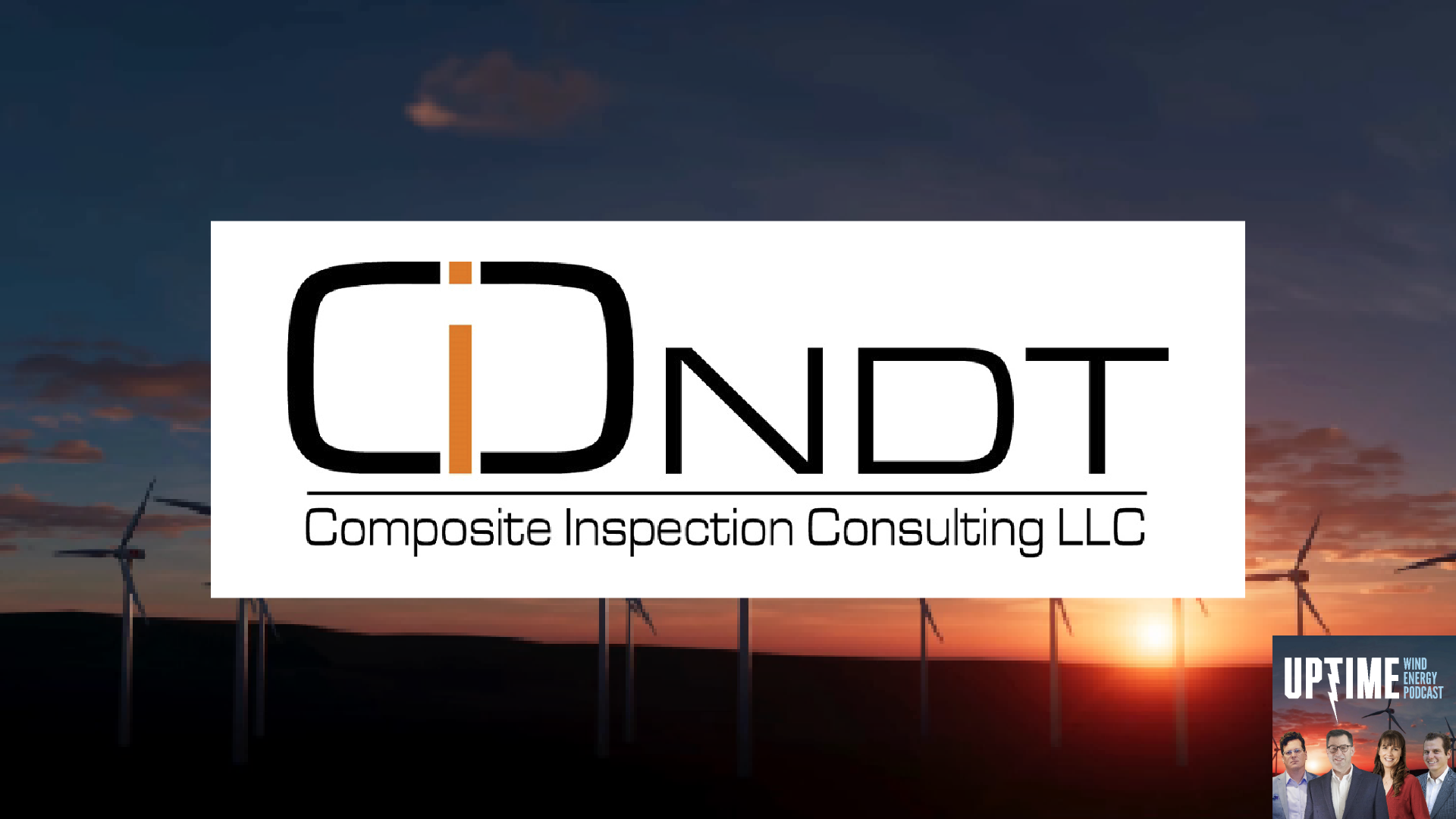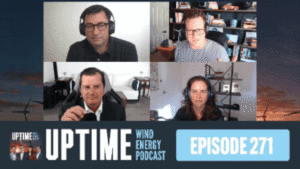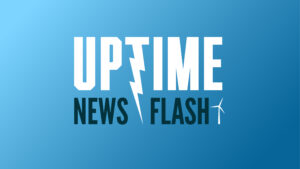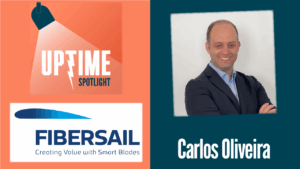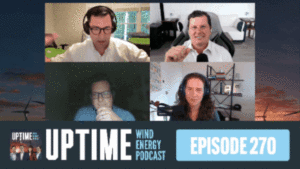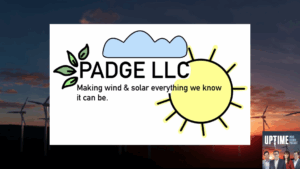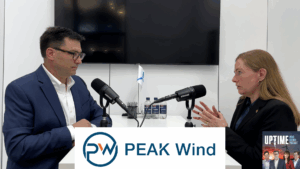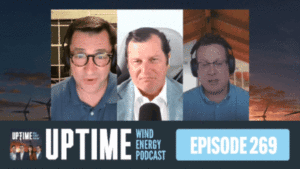Podcast: Play in new window | Download
Jeremy Heinks from CICNDT (Composite Inspection and Consulting NDT) discusses how proper NDT programs can prevent costly failures and improve blade reliability. Drawing from his extensive experience, Heinks explains the challenges of implementing NDT in both onshore and offshore wind environments, emphasizing the importance of working with qualified experts to develop comprehensive inspection.
Fill out our Uptime listener survey and enter to win an Uptime mug! Register for Wind Energy O&M Australia! https://www.windaustralia.com
Sign up now for Uptime Tech News, our weekly email update on all things wind technology. This episode is sponsored by Weather Guard Lightning Tech. Learn more about Weather Guard’s StrikeTape Wind Turbine LPS retrofit. Follow the show on Facebook, YouTube, Twitter, Linkedin and visit Weather Guard on the web. And subscribe to Rosemary Barnes’ YouTube channel here. Have a question we can answer on the show? Email us!
Allen Hall: Welcome back to the Uptime Wind Energy Podcast Spotlight. I’m your host, Allen Hall, along with my co host, Joel Saxum today we’re joined by Jeremy Heinks a true veteran in the field of non destructive testing with over 25 years of experience spanning aerospace, renewables, and the space sectors. Jeremy is the owner of Composite Inspection and Consulting,
where he specializes in advanced materials, testing, and inspection methods. And from inspecting rocket components at SpaceX to developing comprehensive testing programs for wind turbine blades, Jeremy brings a unique perspective on quality assurance and testing
methodologies.
Welcome to Uptime Spotlight, shining light on wind energy’s brightest innovators.
This is the Progress Powering Tomorrow.
Jeremy, welcome to the Uptime Wind Energy Podcast. Thanks for having me. So you’re a person we’ve been wanting to talk to for quite a while. And I’m glad you’re on the podcast because NDT comes up all the time in our discussions when we’re talking to operators, when we’re talking to owners, they don’t know much about it, and they’re not even sure if they got NDT data, if it’s the right kind of data to help them, and you have a ton of experience.
You’ve done aerospace, you worked at SpaceX, you’ve done all this cool NDT stuff. I want to know to start off with. What happens in the factory? What kind of NDT should be performed in the factory? And what are they trying to use it to detect?
Jeremy Heinks: Yeah. In the factory, NDT has come a long way over the past 20 years or so but we start out with the basics people don’t understand like visual inspection is an NDT method and making sure that, that’s done in a proper manner, it’s regulated.
There are rules and regulations for proper visual inspection. And certifying people to that in the NDT realm, it’s called VT here, Visual Technic but, uh, that’s a first just doing proper visual inspection and looking for Gross defects that way. Another thing, that’s another really basic one that we see in the plants is a tap test, right?
And that’s another one. Tap test is a regulated NDT method. And typically that doesn’t, people don’t know that. It gets done incorrectly. 99 percent of the time your technicians that are doing tap tests have to pass certain certifications and regulations for hearing and all these types of different things.
And the same with the conditions for the area to do the tap test. It can’t be a loud noisy area. You have to have, a certain amount of noise or certain, and then we get into a couple of the other basics. One is thermal testing or IR inspection. And when that’s done in a plant, it’s typically after the blade has been closed we’ve put the mold on top and we’ve closed up for the adhesive body to take place.
And the mold is then opened after curing cycle and then pulled out of the out of the mold and set up. So typically we would do a thermal inspection there to make sure that the adhesive is curing properly. Typically if maybe you have an adhesive machine. that has issues.
It would you’d see, areas that didn’t get the initiator or other problems to where maybe you didn’t get enough in there as a cooler area. A lot of different things go on there. And that’s a highly, regulated inspection method as well. It can completely be done improperly in the plant as as we see often.
And another one that’s been pushed pretty far since the 2000s is ultrasonic inspection. That started out with just a really basic single transducer with an A scan squiggly line on a screen. And you’re just looking for a good bond between the laminate of the shell and a web and leading and trailing edge as well.
As far as bond lines go. You can also use that and thermography for looking for dry glass. But we don’t typically see dry glass as much. That was a lot of the infusion technology has come a long way, so we don’t typically see dry glass like we used to but and then, UT morphed into, using a linear array with multiple elements, doing, being able to do a wider area at a single pass again, all, mostly just aimed at bottom lines.
Over the years, we Also, a lot of the plants played with the root inspection because, it’s an important factor, there’s a lot going on in the root sections. But at the end of the day, it comes down to cycle time and how much time you want a plant wants to give to the NDT group if they have it.
So those are the basics that we see in the plant.
Joel Saxum: I think it’s important to touch on this is you say, those are the basics, but anybody that’s been close to NDT understands that NDT is nothing close to anything basic in general, right? It’s very stringent. There’s very, there’s high regulation on it.
And the technology, like when you say, yes, the, an A scan, it’s just a squiggly line on the screen. It takes a lot of education, a lot of knowledge, a lot of experience to, to really be able to tell what these things are. And all of that is driven by process. And one of the things to touch here to our listeners, Jeremy here, CIC NDT, of course, he’s also been the person that worked in LM factories and built their NDT programs and has a ton of experience here.
Can you speak to what it looks like when someone wants to build a program or what that looks like? Cause you’ve been Oracle racing team, Tesla, fighter jets, all kinds of crazy stuff you told us off air. Tell us what that, that, the importance of that program and why someone would implement that.
Jeremy Heinks: Yeah, so the wind energy industry is still very much the wild west when it comes to that type of stuff. So it’s really comes to what is the end user or the customer driving the manufacturer to do. So a lot of it comes down to that. The other thing is if the manufacturer just wants to take it upon themselves to build a better system.
Which we’ve seen in the past, but it typically, for whatever reason, doesn’t seem to stick. A customer will have, a manufacturer will have a problem with a bomb mine. So they’ll spend a bunch of money. We go in, we set up a full bomb mine inspection program for them, train inspectors get experience up, mentor them.
And then once the problem goes away, they seem to think, oh yeah, we beat that. The process is now fixed. We have no more problems. And then five years later, we go through the whole thing again. But yeah we’ve built systems for a few of the blade manufacturers and yeah, typically you’re not going to go out and hire certified NDT technicians.
You’ll get some, a group like my, like CIC or you’ll hire a single level three. And they’ll come in and build a system. And typically it’ll just grab people from the floor and toss them in a room and say, you’re our NET group now. And that’s something on the aviation side, oil gas side that doesn’t happen.
And that’s, that makes you have to deal with a very large learning curve, right? So these guys the upside is if you’re pulling them off a production line, they know the part. And that’s. Coming from the naval aviation side, that was something that we were supposed to do too.
It’s before I could even become an NDT technician in the Navy, I did five years working on aircraft as a, Hydraulics and structural mechanics. So I knew the parts. I knew the aircraft which just makes you a better inspector. Wow.
Allen Hall: All right. This is a little mind blowing here because it’s really complicated.
I think that’s one of the things about NDT that I always complain about is don’t know how difficult it is and management doesn’t tend to know doing an A scan is difficult. I. Did that in aerospace and was around a lot of people who were experts in it, and they could read things on that scope that I just didn’t see.
And they, you’re right, they also have to know what they’re looking at first. You just can’t get a scan, a trace, and go, Oh yeah, there’s a defect here. That is not the case at all. That’s fascinating. So are we starting to see more sort of automation in the factory? We, Joel and I have been to a couple of conferences.
Where they’ve talked about automating some NDT inspections just for throughput, to keep the rate of deliveries up. Is that where we’re going to go in the factory, or is it still really going to be a manual process because of the difficulties with it?
Jeremy Heinks: That’s where we need to go. There’s been a few manufacturers that have tossed a ton of money at this problem.
The problem being that they threw the money at an automation company that did not know NDT. So they came at it with a manufacturing automation set of mind, mindset. And it, every time I’ve seen it it failed pretty spectacularly with, they come up with a solution, but it was just, wasn’t practical.
And you end up with a million and a half dollar piece of equipment sitting on a shelf or in a corner of your factory, just getting, collecting dust or being scavenged off of. Tip, this is where it’s going. We’ve got other industries that have this already done. It’s you’re not, you shouldn’t be reinventing the wheel.
You should just grab the wheel off a different car and put it on yours basically. And yes, it has to get tweaked to wind cause wind’s a little bit different than everything. But but it needs to be driven by an NDT company that. That is either partnered with an automation group that knows NDT or has automation capabilities in house.
I
Joel Saxum: mean, that’s one thing drawing on your background, Jeremy, because you’ve seen I know the first time I talked to you about NDT specifically, we were just standing around and you were like, yeah, it could be this type or that type or this type or that type or this type or that type or this type.
I was like, oh man, like I knew there was some, but I didn’t know there was that many. And to be to go even further than that, I know you guys are partnering with some other companies to build kit that makes sense for wind.
Jeremy Heinks: Yeah. We’re going all in right now with working with Cobots.
So we’ve partnered with a company called Omni NDE out of Tucson. They’re actually going to be moving in with us at our new lab facility in Ogden, Utah. And that’s where we’re going to be pushing for putting most of these methods on end of a Cobot. Cobots are easy to work with. They’re not like industrial robots.
You don’t need a PhD to program them and make sure they don’t crash into your part and ruin, whatever technology you have on the end of it, plus your part. So that’s where we’re going. Other industries do this already. It’s not too innovative. It’s just, bringing it to, to wind.
That’s, like I mentioned earlier, half of our work is in aerospace space DOD stuff. So we try and bring some of that more advanced methodology over to wind and try to bring wind up to speed with everybody else.
Joel Saxum: So that being said, what are some of the problems that you guys are solving in the wind space right now?
Jeremy Heinks: Right now, it’s just trying to standardize inspection. We’re starting to see the re resurgence of some defect types that, especially when we bomb mine. Bond line shouldn’t be an issue. Bond line inspection has been perfected since, like I said, the mid to late 2000s. There are very robust bond line inspection systems out there.
And I know most of the manufacturers have had this in house for a long time. Whether it got kept up with or maybe it fell behind a little bit with technology. But, that’s something we’re seeing. Another one we’re pushing is root inspection. Whether it’s a design issue or manufacturing process issue, the size of these blades and the margins are running them off of, if our design is just pushing that whole area of the blade to the extreme.
And we’re seeing a lot of failures. Some of them, on the newer blade types are like within the first year. Others are hitting that five to seven year mark and failing and root inspection will, even with a basic ultrasonic inspection on a root, you will find the, the precursors or the, the signs of premature failure in that area.
And and then we can usually monitor it. There’s a few ways we can monitor it. Or, there’s a few groups out there working hard on on repairs that, that might be a solution as well.
Allen Hall: So if we work ourselves from the root of the blade to the tip of the blade, can we walk through what are the NDT techniques and the blade bolt, the inserts, what should it be looking for there?
What kind of tools should they be bringing to site if you need someone to do this
Jeremy Heinks: properly? Root section for, the basic would be a low frequency ultrasound. Whether that’s a single element or an array that’s your bare minimum. We typically like to do it from the tool side.
So the external of the blade, but because of the manufacturer of the cells and other things, accessibility is always an issue. So then we have to go to the inside and inside of the blade typically isn’t as smooth, or you’ve got some cosmetic repairs in that area. that have a lot of air and other things that would attenuate ultrasound.
So we have all sorts of problems there. There’s some groups that are, that will log x ray equipment up and that will find yeah, it’s heavy, it’s cumbersome, and the safety stuff up there It’s a, it’s very it’s not an easy thing to do, but they’re doing it and you’ll be able to see whether you’re inserts or bolts or stuff are starting to come free.
We’re actually working on a higher power CT which if anybody’s ever used x ray on composites, it typically doesn’t see what you normally could see with other methods. But if you tried, if we can do a CT, we can get some of that resolution and sensitivity in the inspection. So we’re working on that.
And there’s a couple other ones that could work as well. And, that’s all it works because the Brit inspection has become such a large issue right now. It’ll be interesting to see what comes out over the next couple of years in regards to written inspection working way out.
Another one is, yeah, transverse cracks, wrinkles. When we get into the thicker parts of the main laminate or the spark cap. And typically again, we’re still using ultrasound. There’s some work with microwave and I’m actually going to be working with a group on that and get some equipment out to try and, quantify or certify that inspection.
Laser sclerography is another one which we didn’t really mention earlier, but it’s very good at detecting wrinkles because it’s a strain inspection. You’re going to have weak areas from wrinkles and things like that cracks and whatnot. So yeah, we worked through that.
And then, we amid the main web bond lines looking for the adhesive bonding to the flanges of the web and the skin of the the blade shell. Some other things we hit there are are what they like to call kissing bonds or something being not chemically bonded.
It’s physically bonded, but chem not chemically bonded. And that could be from. Having a chemicals that don’t match properly or you have contamination on the surface when you put, apply the adhesive. And that’s, that one there is really difficult because, composites are one of the most difficult, if not the most difficult material to NDT standpoint.
When you’re doing ultrasound and you see a kissing bot or something like that, a lot of times all you’re seeing is a phase shift. You don’t get to see a dropout or anything else. You still have amplitude at the interface. It’s just a, a 180 out. And if you don’t have things set up properly or you’re not looking for it, you’ll miss it.
And that’s, those are typical problems we have with those type of defect detection. And then from there, we typically go out to the leading and trailing edge. A big problem there is geometry, right? And again, a lot of times you have overlaminations on the trailing edge as well as leading edge.
And when they do an overlamination, they don’t typically get all the air out when they’re putting the layers on. And, again any kind of air or contamination can really make any kind of ultrasound or other method difficult to complete because it blocks signal and energy.
Yeah. And then blade tip areas, whether it’s transport damage or lightning strikes, which you guys know a bit about. Yup.
Allen Hall: Yeah. A lot of that,
Jeremy Heinks: When we get a lightning strike, yeah, you’ll see if the system worked or if it didn’t work, you’ll see where it hit. But a lot of times there’s damage underneath the surface that just isn’t visible and they don’t find it until they’re, how many layers in on a repair and your 10 inch repair turns into six feet, or, that might be pushing a little bit, but.
Those are the types of things that we can find with NDT methods. That way the end user knows what they’re getting into with a repair.
Allen Hall: That’s a really good use case. I think for lightning, because we see so much lightning damage over the past summer, a lot of times it just looks like a pinhole, what the operator describes as a pinhole.
And then they start grinding away and realize this is now a 100, 000 repair and I’ve spent 40, 000 getting to the point of realizing that I have a 100, 000 repair. Why didn’t I bring an NDT? T person out here, just to scan it, just to get a sense of what the scale is here, and whether I need to shut the turbine off, or what the process is.
Why, is it just a lack of knowledge to know how to do that, or what’s preventing that from happening?
Jeremy Heinks: There’s a few things. One is cost. Again, one is time. It does seem to add time, even though in the end it usually saves time. And then it can save cost in the end. It’s just having the vision to see, farther down the line.
Or just the knowledge that we can actually do those type of things on things like that where we might be able to say, okay, maybe you don’t do a repair. Maybe you just do a tip replacement. That’s a thing, it might be cheaper. There’s a lot of companies that do that.
Just having an idea of what you’re getting yourself into can definitely make things better.
Joel Saxum: I was talking to someone the other day, they showed us a damage and we dealt with some repair companies looking at it and stuff. It was a lightning damage, of course. And when you start to see blade like it’s peeled, like the, say the trailing edge opens up or something at that grander scale starts to split up the blade, in the industry we call it banana peeling the blade.
What happens there too though is that you, what you may not see and you, what’s something that is critical to that repair is you need to check that bond line of the shear web. How far, cause it’s possible that it delaminated up way further than you think. And a simple tap test at that, because all of those laminates and composites are loaded in there and stuff like a simple tap test won’t always work to make sure that you’ve, guaranteed the structural integrity of that blade once the repair is done.
And that’s where something that you guys could definitely help with.
Jeremy Heinks: Absolutely. Absolutely. It goes back to tap tests being done properly. And then if the material is extremely thick, if you’re looking at 35 to 60 millimeters of laminate to try and tap through or core or any of these things.
It’s tough and then to hammer it hard enough to get every, a signal change. You could cause damage. I’ve watched tap test guys to actually damage the blade while they’re doing the tests in a plant. And you’re like, Oh, we’ll be repairing that.
Allen Hall: So what are some of the obstacles offshore versus onshore for NDT?
Blades are much bigger, of course. Is that at, and it’s, you’re doing it on ropes. Is that just a huge challenge?
Jeremy Heinks: It is. It’s a giant challenge. NDT from ropes has been a thing for a while, but it’s, and it, NDT and wind has always been an access issue. What can I, what technology can I bring to the blade where it’s at and in the conditions of that it’s in?
When you go offshore, you just multiply that by a thousand, right? Now you have to get out there on a boat or whatever and then get your equipment from whatever vessel you were on onto the platform and then get the equipment up to the top and then get out on the blade and have. You, the equipment, everything’s secure by rope and and then you’re hanging there and you’ve got all these things going on.
You have to run the unit, place the transducer or whatever method you’re using in the right position. Find the right position. Just finding the right spot on a blade that, where they think they have, damage. Is difficult because, a lot of your normal stuff that we take for granted when it lays on the ground, you just can’t do, right?
So yeah,
Joel Saxum: you can’t grab a tape and
Jeremy Heinks: Exactly. So those are the challenges, access, location and then locating defects and then being able to just perform the inspection. And it’s just so much harder in that. And
Allen Hall: CIC NDT has technicians with the capability to go offshore. They have all the qualifications to be there.
There’s very few companies that can even do that work, right?
Jeremy Heinks: Like I said, there’s a, there’s very few. And a lot of them are coming over from oil and gas because they’ve worked up offshore platforms for rigs and stuff. But those guys typically don’t have composites knowledge.
So they have a massive learning curve when they get to the the blade. We’ve had guys that are, we’ve always had guys that are rope access qualified and all that things. But up until recently, we really haven’t had to, recertify and get everybody put together and back out there.
Joel Saxum: So most of your, what would you say most of your. Customer base is in wind. Is it operators? Is it the OEMs? Are you getting called by insurance companies to look at stuff as a subject matter expert? What does that look like for you guys?
Jeremy Heinks: It’s in the last couple years it’s really diversified. It used to be just the OEMs.
Like we would go in they’d figure out they have a problem. They’d bring us into wherever the world that their, R& D facility was or the manufacturing problem occurred. It started from, and we’d work with their engineering groups for a few months, figure everything out. And then, if they wanted to, then we would then execute an inspection project with them.
Now that wind is much more mature globally especially in the U. S. The wind farms are getting older, they get sold off. We’re at the, repower them. All these different things are going on. As well as, blade failures and so we’re starting to get a lot more end user stuff.
And we have started working with groups that do, insurance claims and litigation as well. A little bit of everything. We tend to I really enjoy working with the end users now. It’s it’s a little bit, it’s pretty gratifying, but we work with everybody. It’s always good to stop a problem before it becomes an issue.
So we’d like to
Joel Saxum: be as far upstream as possible as well. Yeah. We don’t want, we want like less blade liberations in the market. And you guys are the ones that call to help that.
Allen Hall: And if you go to CIC NDT’s website, one of the first things is consulting. And I think this is always the first move.
Don’t bring somebody in to go look at a particular part of a blade without talking to someone like Jeremy, because he knows more likely what you need. It can get you to the solution faster. And that’s your website, by the way is fantastic. It’s extremely helpful as to what the technologies are, what the applications are, Who to talk to, and that’s, one of the things I always advise operators.
Talk to an expert, someone who really knows. Don’t just hire an ISP to go out and do this thing. You want to talk to someone like Jeremy who is the expert. And Jeremy, how do people connect with you? You should get, as Joel has pointed out, you’re in aerospace, you’ve done space stuff, you’ve done boats, you’ve done all kinds of NDT work.
How do they connect to you to get your expert advice on
Jeremy Heinks: Yeah, the easiest thing is go to the website and there’s a couple ways to contact us there. Otherwise we’re on LinkedIn. Most of my team members are on LinkedIn and the company has a LinkedIn page as well. So those are the easiest way to get to all of us.
If we don’t have the answers, we typically know people that do. We’re now well networked. We’ve been, a lot of my guys have been in the wind industry. That’s early 2000s, so we have a lot of expertise. We know a lot of people. Yeah, if we can’t answer your questions, we definitely know somebody that can.
And the way we get past these these problems if we work together.
Allen Hall: Absolutely. So go check out cicndt. com or reach out to Jeremy via LinkedIn and get some advice. Get your blades checked out properly. Jeremy, thank you so much for being on the podcast. We love talking to you. You’re so full of expertise on NDT.
It’s really cool. Appreciate your time.
Jeremy Heinks: No problem. It’s always good



